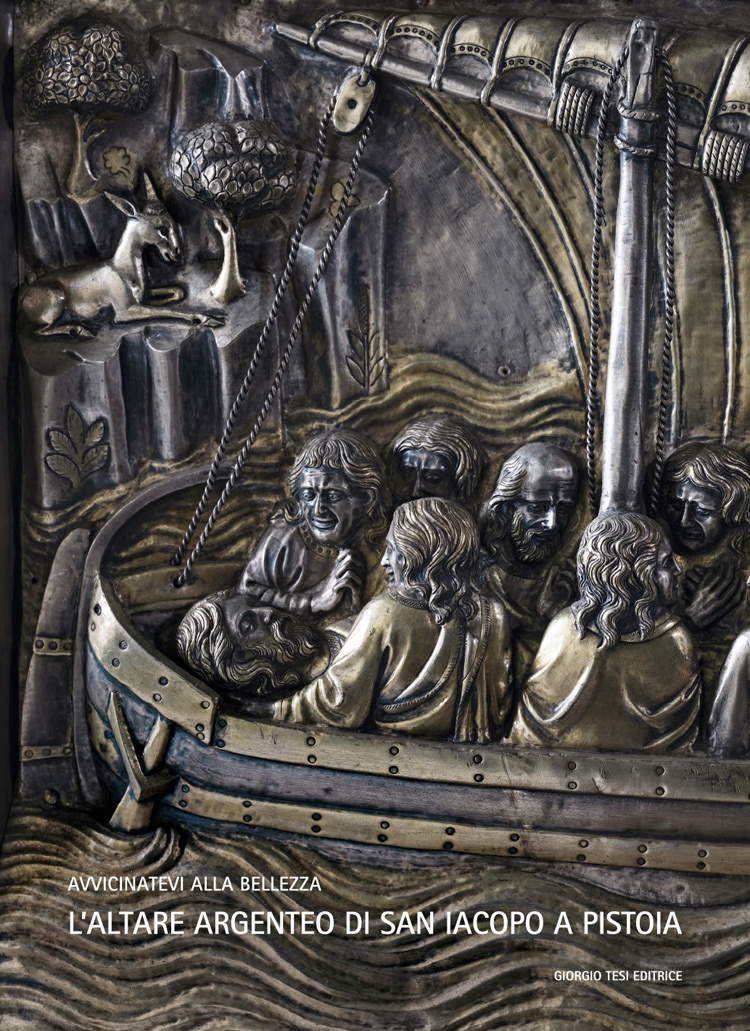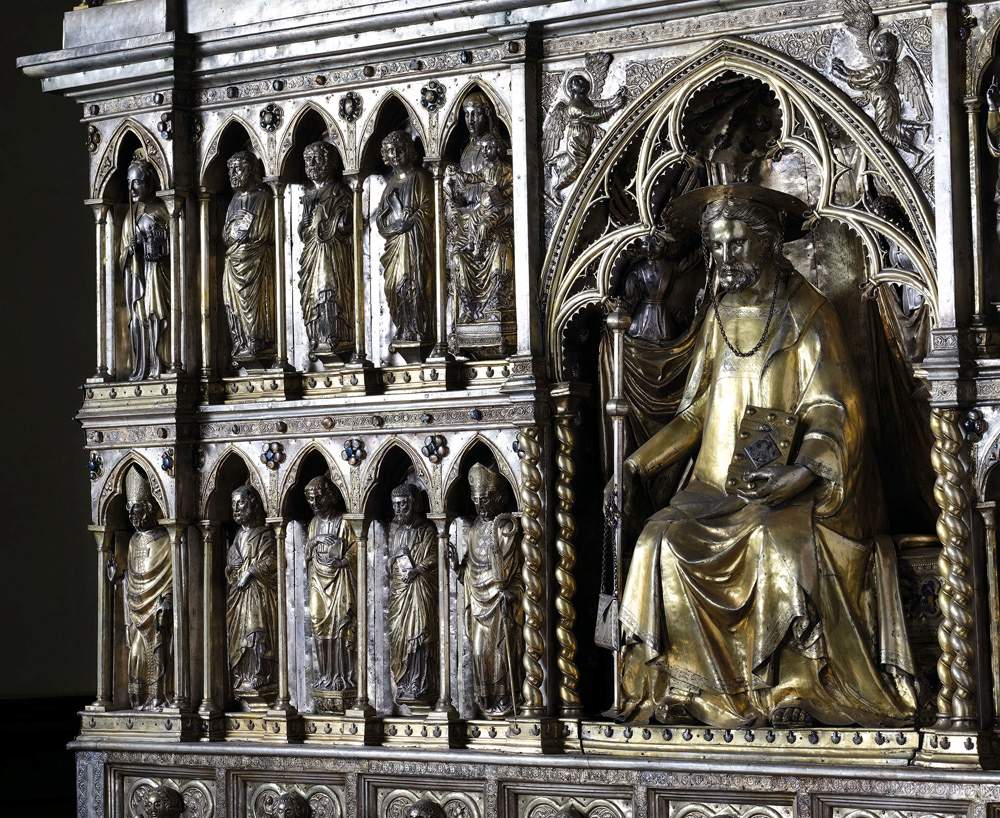Thesilver Altar of San Iacopo, a masterpiece of 13th-century goldsmithing art preserved in the Cathedral of San Zeno in Pistoia, is the protagonist of a new book, published by Giorgio Tesi Editrice: the volume, the fourth in the series Approach to Beauty, aims to tell the story of the extraordinary masterpiece, which turns 731 years old in 2018. In fact, the making of the altar began in 1287 and continued for no less than one hundred and sixty-nine years, until 1456, involving some of the most talented goldsmith masters of the time. The book, edited by art historian Lucia Gai and strong with an apparatus of images taken by Nicolò Begliomini (with a modern and innovative style, also aimed at highlighting details that are barely visible to the naked eye), will be presented Saturday, December 1 December, at 4 p.m., at the Cathedral of San Zeno in Pistoia, and will be introduced by a lectio magistralis by Antonio Paolucci, former minister of cultural heritage, superintendent for the Polo Museale Fiorentino, and director of the Vatican Museums. The book was produced in agreement with the Cathedral Chapter, the Diocese of Pistoia, the Ministry of Cultural Heritage, the City of Pistoia and the Confraternity of San Iacopo di Compostela, with contributions from Giorgio Tesi Group, Fondazione Caript, AIB Broker and Conad del Tirreno. In addition to Antonio Paolucci, Lucia Gai and Nicolò Begliomini, the presentation will be attended by the mayor of Pistoia, Alessandro Tomasi, the bishop of Pistoia, Fausto Tardelli, the archpriest of the Cathedral, Luca Carlesi, ecclesiastical representatives of Santiago de Compostela and Paolo Caucci von Saucken, a member of the International Committee of Experts on Worship and the Camino de Santiago, as well as rector of the Confraternity of San Jacopo di Compostela.
The silver Altar of San Iacopo is in fact a kind of bridge between Pistoia and Santiago de Compostela (the two cities will moreover be united by a twinning): the cult of the saint was introduced in the Tuscan city in 1145, when the Vallombrosian bishop Atto brought to Pistoia the only relic of the saint present in Italy. Pistoia, which thus became a stop on the pilgrimage to Galicia, saw its international horizons broaden and witnessed a flourishing cultural growth. The Altar of San Iacopo was commissioned precisely to hold the precious relic. The silver masterpiece also recently underwent a decisive cleaning operation (also funded by Giorgio Tesi Editrice), which also involved replacing some of the glass. On this occasion, the Opificio delle Pietre Dure, on the occasion of Nicolò Begliomini’s photographic campaign, took some samples intended for analysis in order to understand what the altar’s current state of conservation is, with a view to future restoration.
“In this world in lively ferment, which in addition to the classic and somewhat rhetorical historical reconstructions, appears to be made up of fictional stories in which men (and sometimes women) so similar to us in facing the important moments of existence are the protagonists,” says Lucia Gai, “the cult and the Jacobean pilgrimage was born.” The silver altar immortalizes not only the cult, but the society and spirit of the time: “it is therefore,” Gai continues, “not only an important work of goldsmith’s art between the Middle Ages and the Renaissance, but also the most relevant testimony, condensed into figurative images, of the way of being and living of religiosity and the ethics of sociality, continues the st ory of art.”
“L’Altare argenteo di San Iacopo,” Antonio Paolucci declares instead, “is indeed a long-awaited volume that man cava in the Italian art-historical bibliography. This wonderful book deals with the Silver Altar from several points of view-historical, archival, artistic and styles-and is accompanied by an exceptional photographic campaign, so much so that it comes incredibly close to the real thing. Lucia Gai identifies the authors, selects them and ’scrutinizes’ them, allow me the term, in their artistic specificity and stylistic evidence. Thanks to this book, it will be possible to deepen one’s knowledge with that silver mastodon located inside the Cathedral of San Zeno - which holds the precious relic of the head of St. James the Apostle - on which five generations of goldsmiths worked, from the 1300s to Brunelleschi, very important in the pilgrims’ Way to Santiago de Compostela.”
The book, already translated into English and Spanish, will then be presented in late December in Santiago de Compostela on the occasion of the Feast of the Translation of the Apostle’s body from Palestine to Galicia after his martyrdom. And also Giorgio Tesi Editrice is working on the production of a docufilm chronicling the “march of approach” between Pistoia and Santiago de Compostela: some stages will be filmed, accompanied by interviews with experts and protagonists of the journey. The volume (with facing texts in Italian, English and Spanish) consists of 240 pages, the cover price is 25 euros and during the presentation it will be available for purchase at the special price of 20 euros. This is yet another chapter in Giorgio Tesi Editrice’s many years of activity in the enhancement of art: first with the magazine Naturart, which since 2010 has been chronicling the artistic, cultural and naturalistic excellence of the Pistoia area, with texts and photos edited by professionals in the field (each issue is printed in 8,000 copies, 2.000 of which are distributed in and around Pistoia, and the others in Italy and abroad), and then with publications related to art and landscapes (of particular note is the volume Il restauro del fregio robbiano, entirely dedicated to the phases of the restoration of the terracotta frieze made in the early 16th century by Santi Buglioni for the Ospedale del Ceppo in Pistoia).
For more information you can visit Giorgio Tesi Editrice’s website, and www.discoverpistoia.it.
Below is the book cover and some pictures of the silver altar of San Iacopo.
 |
 |
 |
 |
| Pistoia, Antonio Paolucci discusses the Silver Altar of San Iacopo, a masterpiece of 13th-century goldsmith art |
Warning: the translation into English of the original Italian article was created using automatic tools. We undertake to review all articles, but we do not guarantee the total absence of inaccuracies in the translation due to the program. You can find the original by clicking on the ITA button. If you find any mistake,please contact us.